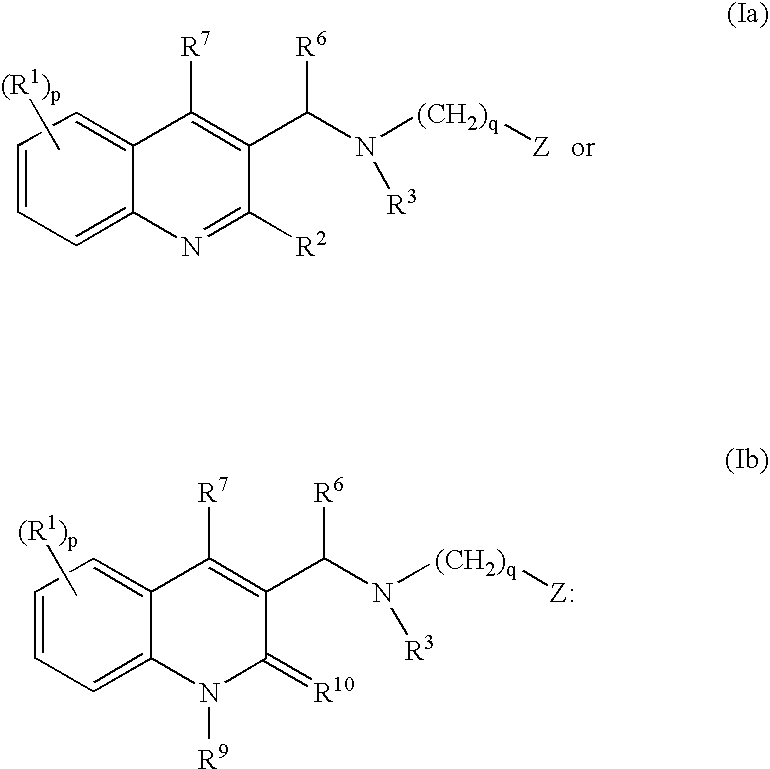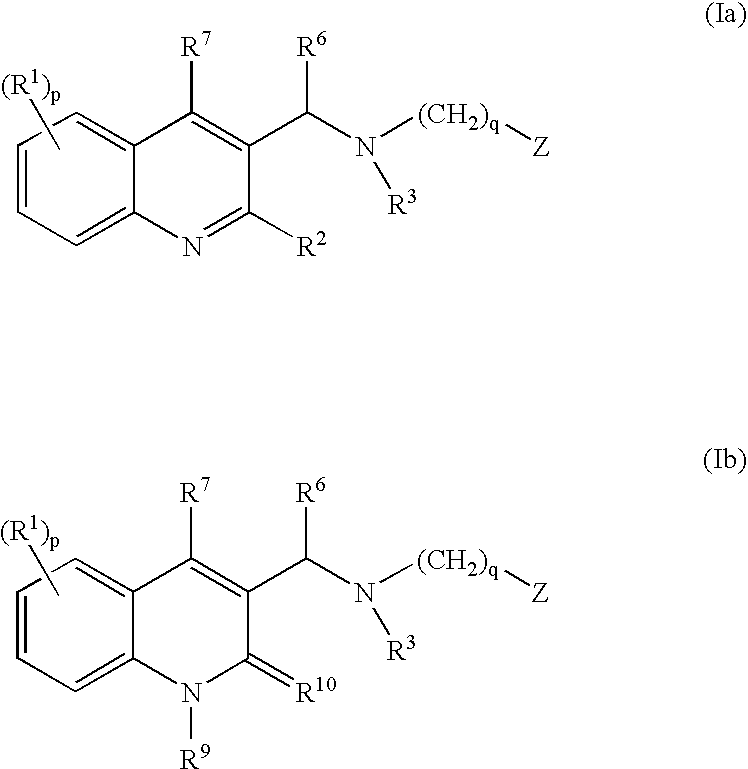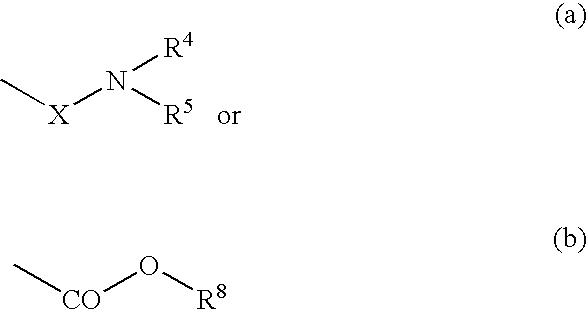Antibacterial Quinoline Derivatives
a technology of quinoline and derivatives, applied in the direction of biocide, antibacterial agents, drug compositions, etc., can solve the problems of unfavorable clinical treatment of single agents, high cost, and ineffectiveness of mdr-tb, and achieve effective combating bacterial infections, uniform dosage, and convenient administration.
- Summary
- Abstract
- Description
- Claims
- Application Information
AI Technical Summary
Benefits of technology
Problems solved by technology
Method used
Image
Examples
example a1
a) Preparation of Intermediate 1
[0159]
[0160]A mixture of 5-bromo-1H-indole-2,3-dione (0.066 mol) in NaOH 3N (150 ml) was stirred at 80° C. for 30 minutes, then brought to room temperature. 1,3-diphenyl-1-propanone (0.066 mol) was added and the mixture was heated to 80° C. overnight then cooled and acidified to pH 5 with acetic acid. The precipitate was filtered off, washed with H2O and diisopropyl ether and dried. Yield: 15 g of intermediate 1 (55%).
b) Preparation of Intermediate 2
[0161]
[0162]A mixture of intermediate 1 (15 g) in diphenylether (150 ml) was stirred at 300° C. overnight. The resulting mixture was purified by column chromatography over silica gel (eluent: cyclohexane: 100). The pure fractions were collected and the solvent was evaporated. Yield: 3.0 g of intermediate 2 (22%).
c) Preparation of Intermediate 3
[0163]
[0164]A mixture of intermediate 2 (0.0027 mol), 1-bromo-2,5-pyrrolidinedione (0.0027 mol) and dibenzoylperoxide (0.00005 mol) in CCl4 (10 ml) was stirred and r...
example a2
a) Preparation of Intermediate 4
[0165]
[0166]Benzene propanoyl chloride (0.488 mol) was added dropwise at room temperature to a solution of 4-bromobenzenamine (0.407 mol) in Et3N (70 ml) and CH2Cl2 (700 ml) and the mixture was stirred at room temperature overnight. The mixture was poured out into water and concentrated NH4OH, and extracted with CH2Cl2. The organic layer was dried (MgSO4), filtered, and the solvent was evaporated. The residue was crystallized from diethyl ether. The residue (119.67 g) was taken up in CH2Cl2 and washed with HCl 1N. The organic layer was dried (MgSO4), filtered, and the solvent was evaporated. Yield: 107.67 g of intermediate 4 (87%).
b) Preparation of Intermediate 5
[0167]
[0168]The reaction was carried out twice. POCl3 (1.225 mol) was added dropwise at 10° C. to DMF (0.525 mol). Then intermediate 4 (0.175 mol) was added at room temperature. The mixture was stirred overnight at 80° C., poured out on ice and extracted with CH2Cl2. The organic layer was drie...
example a3
Preparation of Intermediate 8
[0173]
[0174]A mixture of intermediate
6-bromo-3-(bromo-phenyl-methyl)-2-chloro-quinoline (prepared in an analogous manner to A2.d) (0.0036 mol), N,N-dimethyl-N′-(phenylmethyl)-1,2-ethanediamine (0.0036 mol) and K2CO3 (0.0036 mol) in CH3CN (20 ml) was stirred at 80° C. for 12 hours. The solvent was evaporated. The mixture was extracted with CH2Cl2 / H2O. The organic layer was separated, dried (MgSO4), filtered, and the solvent was evaporated. The residue (2.3 g) was purified by column chromatography over silica gel (eluent: CH2Cl2 / CH3OH 98 / 2; 70-200 μm). The desired fraction was collected and the solvent was evaporated. Yield: 0.4 g of intermediate 8.
PUM
| Property | Measurement | Unit |
|---|---|---|
| body weight | aaaaa | aaaaa |
| pH | aaaaa | aaaaa |
| temperature | aaaaa | aaaaa |
Abstract
Description
Claims
Application Information
 Login to View More
Login to View More - R&D
- Intellectual Property
- Life Sciences
- Materials
- Tech Scout
- Unparalleled Data Quality
- Higher Quality Content
- 60% Fewer Hallucinations
Browse by: Latest US Patents, China's latest patents, Technical Efficacy Thesaurus, Application Domain, Technology Topic, Popular Technical Reports.
© 2025 PatSnap. All rights reserved.Legal|Privacy policy|Modern Slavery Act Transparency Statement|Sitemap|About US| Contact US: help@patsnap.com



